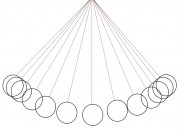An unnamed dairy farm family struggles with family dynamics as a drought has hit their local environment. The patriarch (Brian F. O’Byrne) has dirt-stained fingernails and is strict with his children, in hopes they will acquire the grit to take over the family farm. The mother (Catalina Sandino Moreno) is deaf and mute, but loving and gorgeous. They have five children; the eldest two are discovering their sexuality with trysts in the woods or lifting a pornographic magazine from the local convenience store. When one of the children witnesses his mother’s infidelity, it shakes the family in the most subtle ways.
The film begins with the entire family enjoying a lovely dip in a nearby pond and taking photos to capture the moment. Yet, it’s the last time they seem truly together, as we soon find them alienated from each other. The children begin to form their personalities, discover their sexuality, and realize the hard work it takes to run a farm. Their house is showing signs of wear with paint peeling inside and outside of the structure, no thanks to the increasing heat from the drought.
Medeas is told not as a conventional narrative with formalist film grammar, but as a series of vignettes with Neorealist tendencies, placing a spotlight on the psycho-dramatic conflicts within each family member. As a character study, there is no delineation between protagonists and antagonists. The family is struggling economically, emotionally, and dynamically, both from natural human development and with reactive human emotion.
The Southern Californian landscape looks more like the Depression-era Dust Bowl rather than a contemporary setting; only the modern milking machines give away the film’s time-period. Even a scene where the father brings home an old dial television that barely retains a reception gives the film a sense that it’s more from A Christmas Story time period than of the 21st century.
The film has very little dialogue, but the tension is so stiff and expressive that only a handful of sentences are necessary to help the visuals tell the rest of the story. Shots are often placed through doorways, cutting the horizontal panoramic shots into confined spaces where these characters exist both physically and emotionally.
What is rare for even independent films, Medeas was shot on 35mm film, but the evidence of such a format is only seen in the seldom flickers of dirt and fibers on the film stock. The film features a crisp color palate and the images are incredibly detailed as hairs on the young teenage girl’s head fly about through the wind clearly, proof that the film is shot and executed by master filmmakers. Existing more on the same contemplative plane as The Tree of Life, Medeas has a communicative visual nature that is transformative and effervescent.








